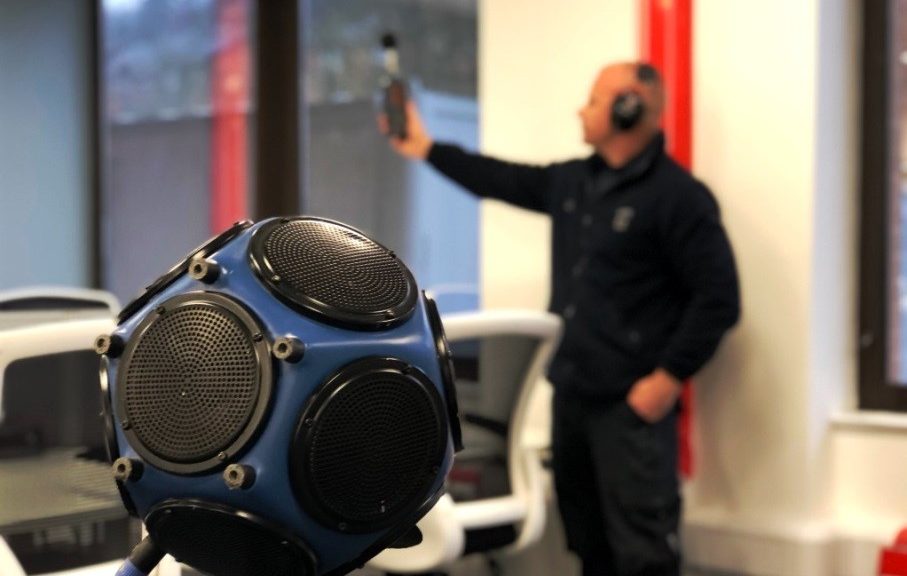
Why Have I Failed my Sound Insulation Test?
Why Have I Failed my Sound Insulation Test?
This is one of the most common questions we get asked by clients when their property has failed the sound testing. One of the main reasons for acoustic partitions failing the Part E sound test is often down to poor isolation of material/s, which can lead to excessive noise flanking. Noise Flanking is a term used by acoustic engineers to describe where sound passes through an acoustic partition due to the abutment of materials. The noise simply hits one side of the wall and then travels through the construction via a noise bridge. This can be areas such as the incorrect use of masonry wall ties i.e. solid fishtail ties, used in place of specified acoustic wall ties.

Unwanted noise travelling along flanking paths can make the building structure vibrate, which can cause sound to radiate into your room. One simple cost effective solution is to build another wall or ceiling in front of the original, to offer extra isolation. For this upgrade to work you need to make sure that the independent wall or ceiling is not directly connected to the existing failed partition; so it provides isolation between materials.
Another reason for excessive noise flanking is often down to the use of down to the use of lightweight blocks in the construction of the building envelope. Due to the lightweight mas of the inner wall it allows sound to transmit from dwelling to another, both vertically and horizontally. If a building has failed its sound testing, it is essential to establish if the problem is due to direct transmission, flanking transmission or a combination of both so that the most cost and time effective remedial treatment can be designed and applied to the failed partitions.
One of the easiest ways to reduce the chance of sound testing failures due to excessive noise flanking transmission is through careful consideration of the acoustic design at the start of the project. Unfortunately, by simply specifying high-performance wall and floor partitions, it is no guarantee to adequate sound isolation and successful sound testing.
We offer preconstruction design advice to help you achieve successful sound testing in-line with Building Regulations Part E. We also offer onsite inspection services to ensure that the sound insulation elements are being installed as per manufactures guild-lines, as it’s no use having good acoustic design if it not being installed properly on site.
During early design and construction process, we visit site to conduct a comprehensive acoustic design survey and review, we also take this opportunity to meet; where possible, the site/project manager, architects etc. The first stage of the acoustic design is to send through the design drawings – to include sections etc. We then review the design to check that the construction details proposed are capable of passing the sound tests. This usually takes place straight after planning has been approved as increased cost savings can be realised at the earliest stage, we will evaluate the construction methods and materials specified to ensure that they are capable of meeting the acoustic requirements of Approved document E.
The typical areas we check are:
a. There are no flanking points, where isolated partitions are wrongly mechanically fixed together to caused noise bridging.
b. The walls and floors design are acoustically robust, to comply with Building Regulations Part E.
c. The acoustic treatments for Soil Pipes, Stair Cases Steel Beams etc. to ensure they are acoustically fit for purpose, as these are some of the areas that get usually missed.
d. Acoustic floor treatments are compatible with the proposed floor finishes i.e. Carpets, Laminates, Floor Tiles and under floor heating systems.
We also provide on-going design support service, so you will have direct contact with the allocated acoustician from the start of the process through to the successful completion of the project. One of the most important services is the going site survey visits which allow our clients to feel confident about the outcome of testing at the end of the build. The site visits let us check that the installation teams are installing the acoustic materials as per manufacturers avoiding crucial onsite mistakes. You can often have a compliant design which still fails due to poor workmanship; the site survey visits negate the risk of sound test failure.
We also offer an acoustic advice service for clients that have failed their sound testing. We offer simple solutions to reduce the noise levels and achieve compliance with Part E. We can supply simple easy to follow acoustic design reviews, utilising our extensive knowledge of different materials and construction methods
If you require more information about acoustic design and/or sound testing on your project, please visit the APT Sound Testing website or call direct on 07775 623464.